fuel TOYOTA TACOMA 2019 (in English) Owner's Guide
[x] Cancel search | Manufacturer: TOYOTA, Model Year: 2019, Model line: TACOMA, Model: TOYOTA TACOMA 2019Pages: 700, PDF Size: 12.83 MB
Page 506 of 700
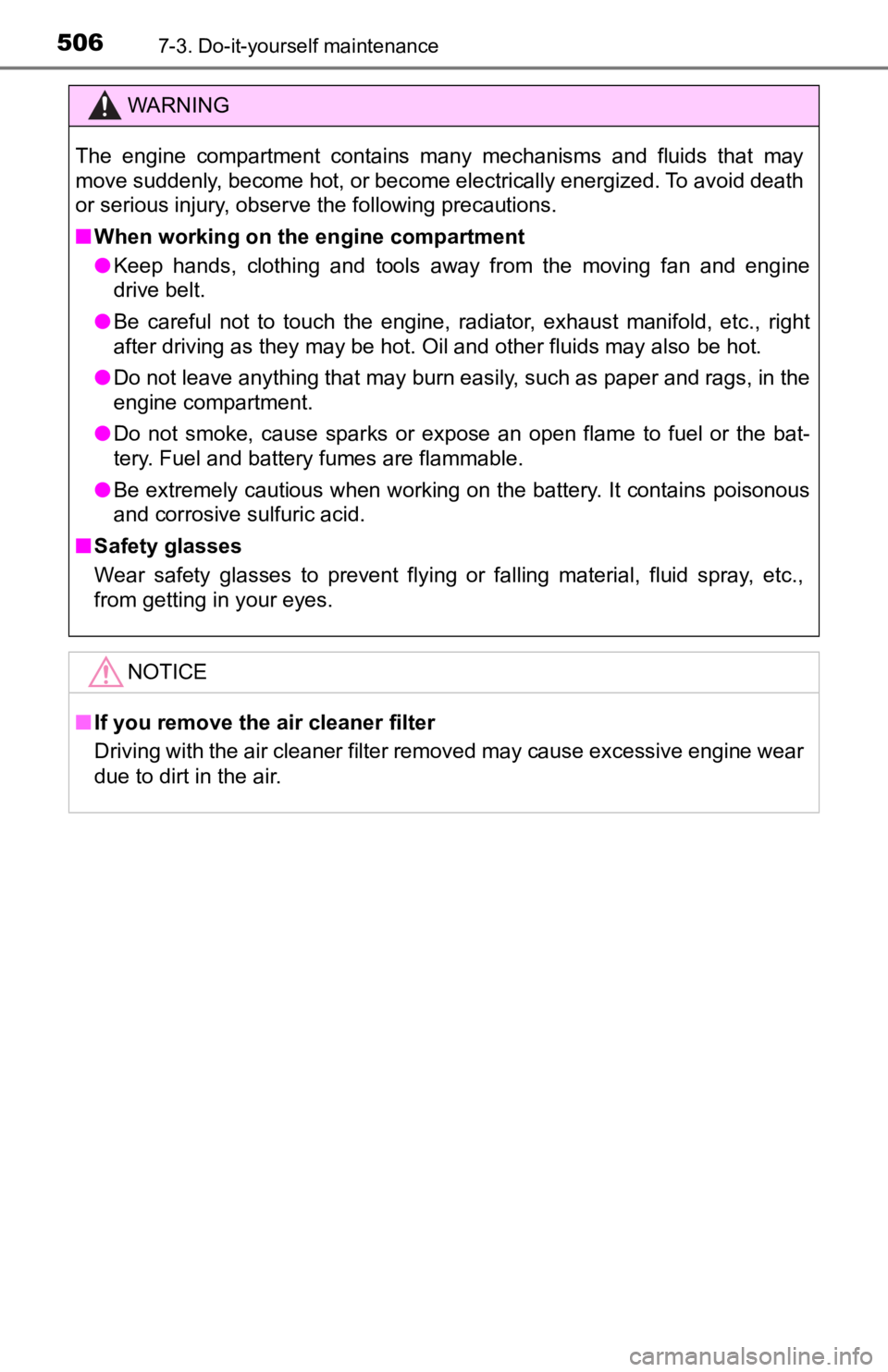
5067-3. Do-it-yourself maintenance
WARNING
The engine compartment contains many mechanisms and fluids that may
move suddenly, become hot, or become electrically energized. To avoid death
or serious injury, observe the following precautions.
■ When working on the engine compartment
● Keep hands, clothing and tools away from the moving fan and engine
drive belt.
● Be careful not to touch the engine, radiator, exhaust manifold, etc., right
after driving as they may be hot. Oil and other fluids may also be hot.
● Do not leave anything that may burn easily, such as paper and r ags, in the
engine compartment.
● Do not smoke, cause sparks or expose an open flame to fuel or t he bat-
tery. Fuel and battery fumes are flammable.
● Be extremely cautious when working on the battery. It contains poisonous
and corrosive sulfuric acid.
■ Safety glasses
Wear safety glasses to prevent flying or falling material, fluid spray, etc.,
from getting in your eyes.
NOTICE
■If you remove the air cleaner filter
Driving with the air cleaner filter removed may cause excessive engine wear
due to dirt in the air.
Page 531 of 700
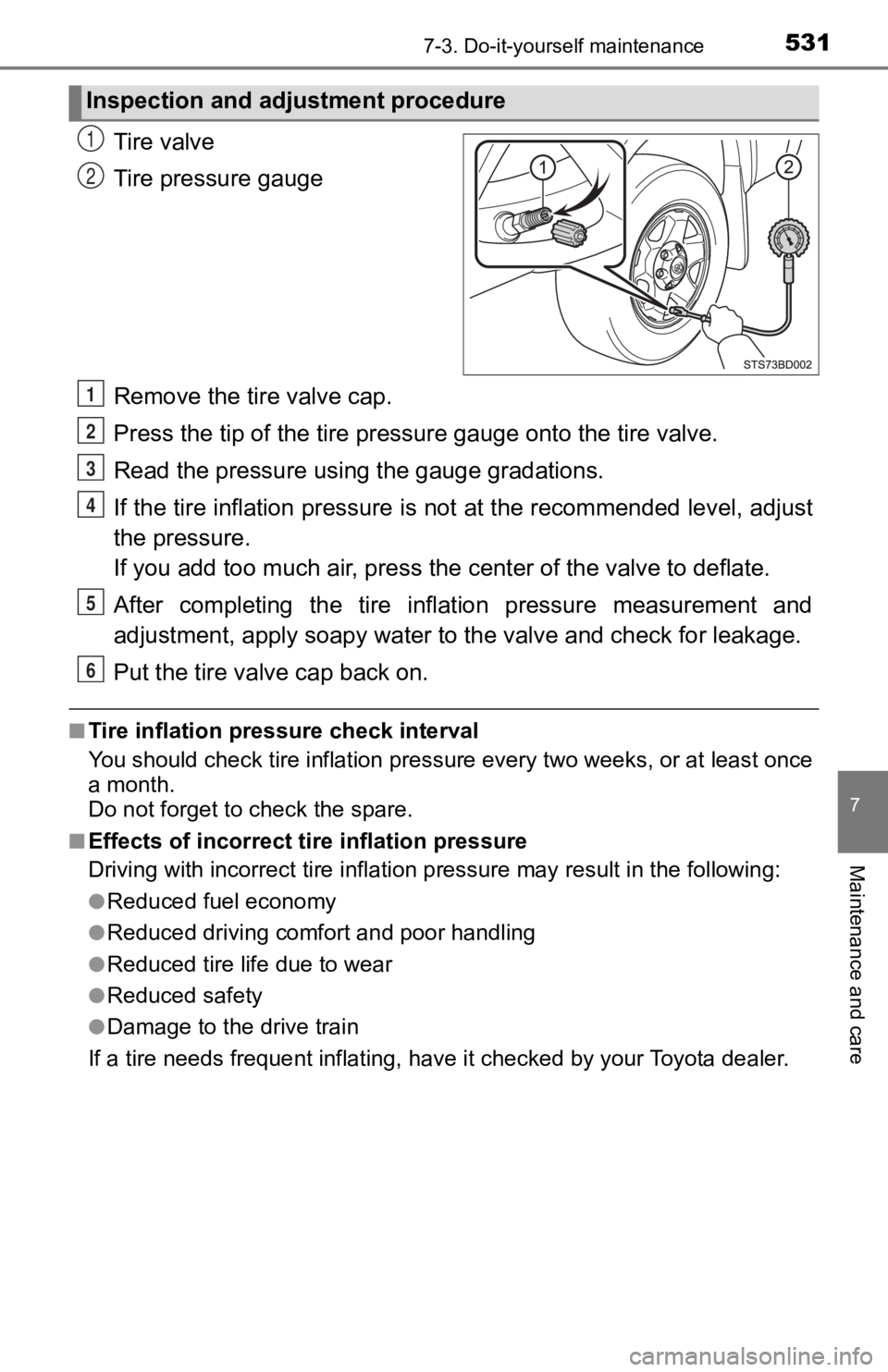
5317-3. Do-it-yourself maintenance
7
Maintenance and care
Tire valve
Tire pressure gauge
Remove the tire valve cap.
Press the tip of the tire pressure gauge onto the tire valve.
Read the pressure using the gauge gradations.
If the tire inflation pressure is not at the recommended level, adjust
the pressure.
If you add too much air, press the center of the valve to defla te.
After completing the tire inflation pressure measurement and
adjustment, apply soapy water to the valve and check for leakage.
Put the tire valve cap back on.
■Tire inflation pressure check interval
You should check tire inflation p ressure every two weeks, or at least once
a month.
Do not forget to check the spare.
■Effects of incorrect tire inflation pressure
Driving with incorrec t tire inflation pressure may result in th e following:
●Reduced fuel economy
●Reduced driving comfort and poor handling
●Reduced tire life due to wear
●Reduced safety
●Damage to the drive train
If a tire needs frequent inflating , have it checked by your Toyota dealer.
Inspection and adjustment procedure
1
2
1
2
3
4
5
6
Page 557 of 700

557
8When trouble arises
8-1. Essential informationEmergency flashers .......... 558
If your vehicle has to be stopped in
an emergency ................. 559 8-2. Steps to take in an emergency
If your vehicle needs to be towed ......................... 561
If you think something is wrong .............................. 566
Fuel pump shut off system ............................ 567
If a warning light turns on or a warning buzzer
sounds ............................ 568
If a warning message is displayed......................... 575
If you have a flat tire.......... 597
If the engine will not start ................................. 612
If the electronic key does not operate properly
(vehicles with a smart key
system) ........................... 614
If the vehicle battery is discharged ...................... 616
If your vehicle overheats ... 620
If the vehicle becomes stuck ............................... 622
Page 567 of 700
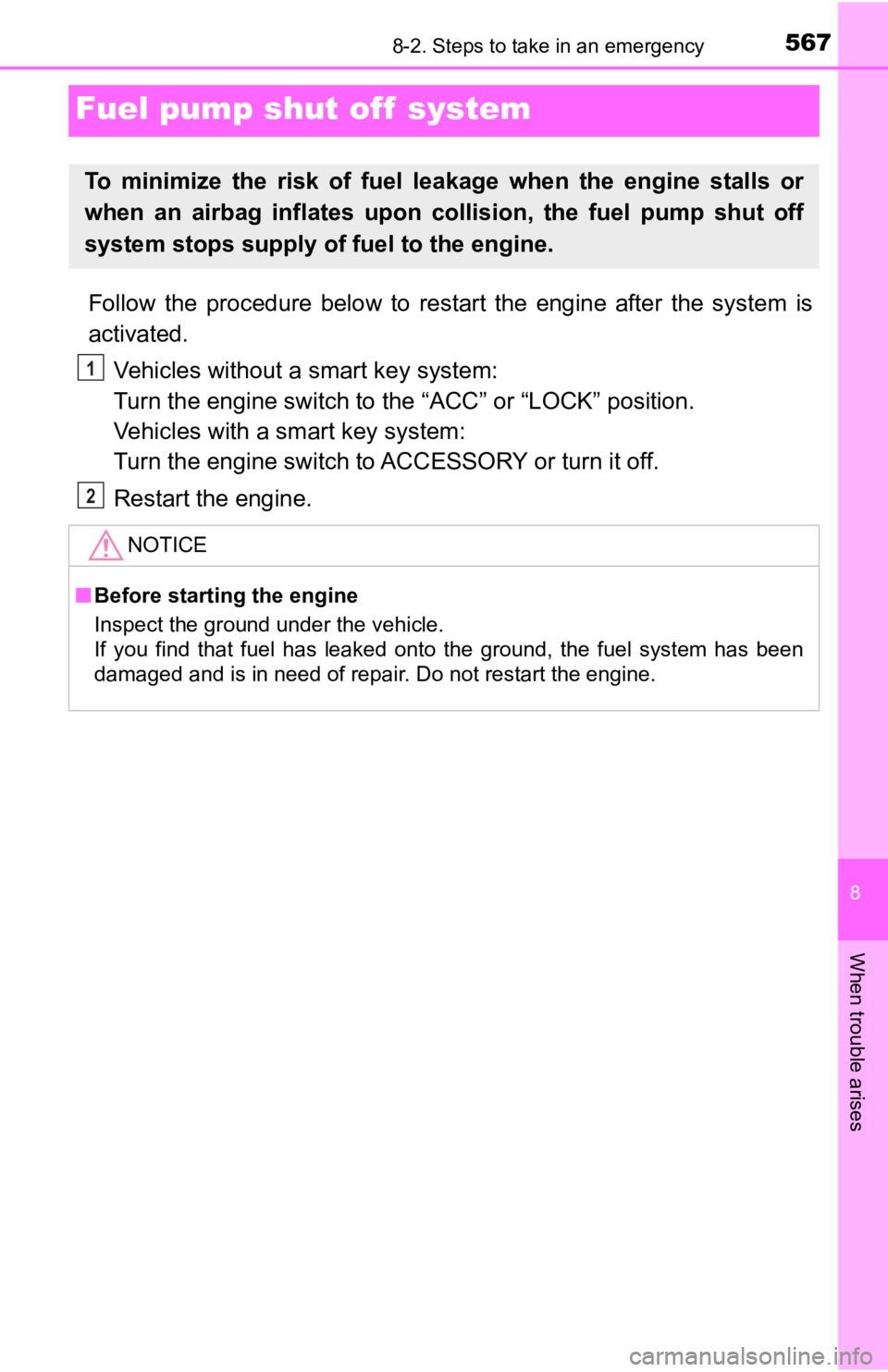
567
8
When trouble arises
8-2. Steps to take in an emergency
Fuel pump shut off system
Follow the procedure below to restart the engine after the system is
activated.
Vehicles without a smart key system:
Turn the engine switch to the “ACC” or “LOCK” position.
Vehicles with a smart key system:
Turn the engine switch to ACCESSORY or turn it off.
Restart the engine.
To minimize the risk of fuel leakage when the engine stalls or
when an airbag inflates upon collision, the fuel pump shut off
system stops supply of fuel to the engine.
NOTICE
■ Before starting the engine
Inspect the ground under the vehicle.
If you find that fuel has leaked onto the ground, the fuel system has been
damaged and is in need of repair. Do not restart the engine.
1
2
Page 569 of 700
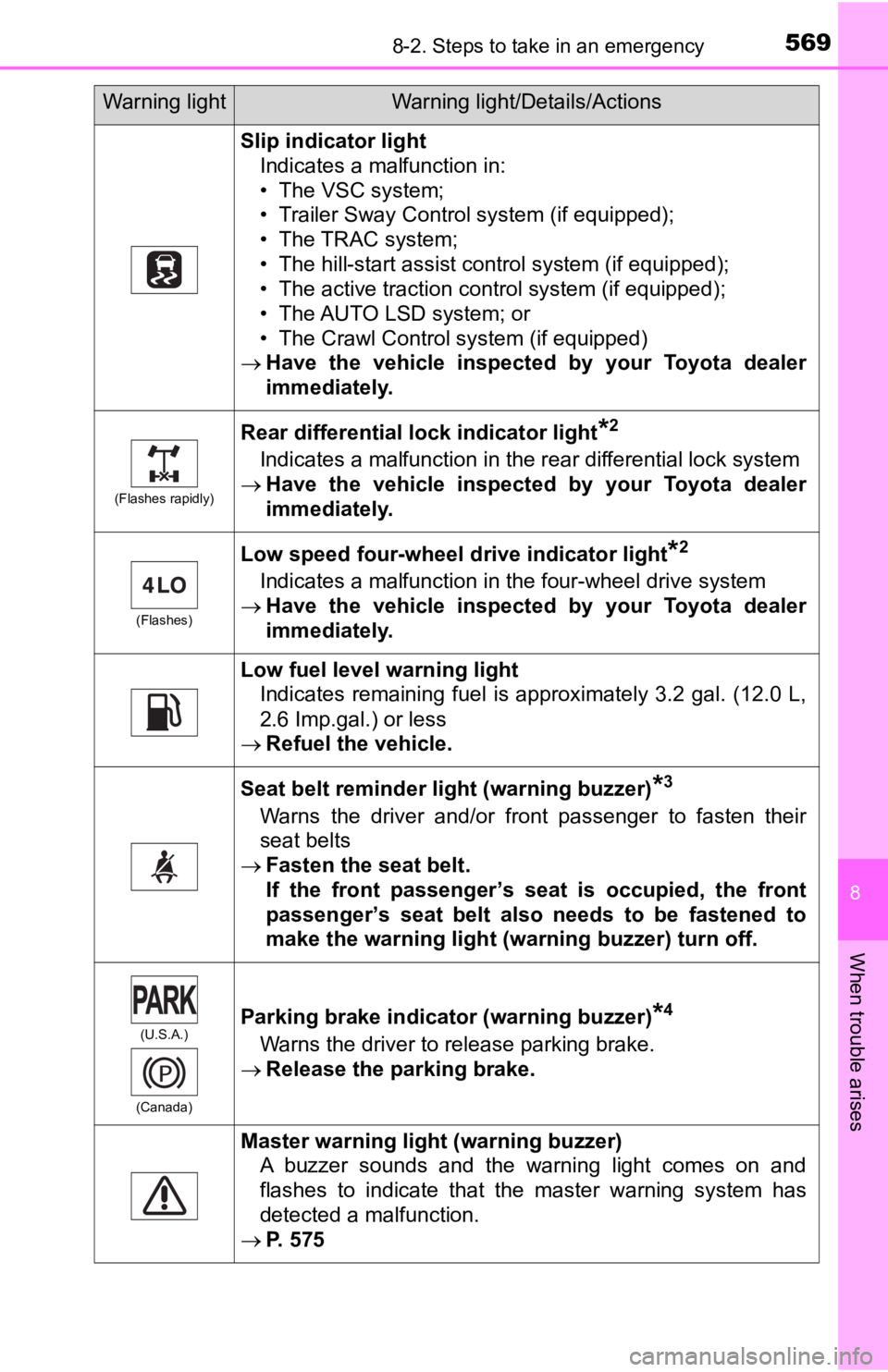
5698-2. Steps to take in an emergency
8
When trouble arises
Slip indicator lightIndicates a malfunction in:
• The VSC system;
• Trailer Sway Control system (if equipped);
• The TRAC system;
• The hill-start assist control system (if equipped);
• The active traction control system (if equipped);
• The AUTO LSD system; or
• The Crawl Control system (if equipped)
Have the vehicle inspected by your Toyota dealer
immediately.
(Flashes rapidly)
Rear differential lock indicator light*2
Indicates a malfunction in the rear differential lock system
Have the vehicle inspected by your Toyota dealer
immediately.
(Flashes)
Low speed four-wheel drive indicator light*2
Indicates a malfunction in the four-wheel drive system
Have the vehicle inspected by your Toyota dealer
immediately.
Low fuel level warning light
Indicates remaining fuel is approximately 3.2 gal. (12.0 L,
2.6 Imp.gal.) or less
Refuel the vehicle.
Seat belt reminder light (warning buzzer)*3
Warns the driver and/or front passenger to fasten their
seat belts
Fasten the seat belt.
If the front passenger’s seat is occupied, the front
passenger’s seat belt also needs to be fastened to
make the warning light (warning buzzer) turn off.
(U.S.A.)
(Canada)Parking brake indicator (warning buzzer)*4
Warns the driver to release parking brake.
Release the parking brake.
Master warning light (warning buzzer)
A buzzer sounds and the warning light comes on and
flashes to indicate that the master warning system has
detected a malfunction.
P. 575
Warning lightWarning light/Details/Actions
Page 572 of 700

5728-2. Steps to take in an emergency
■If the malfunction indicator lamp comes on while driving
First check the following:
●Is the fuel tank empty?
If it is, fill the fuel tank immediately.
● Is the fuel tank cap loose?
If it is, tighten it securely.
The light will go off after several driving trips.
If the light does not go off even after several trips, contact your Toyota dealer
as soon as possible.
■
When the tire pressure warning light comes on (if equipped)
Check the tire inflation pressure and adjust to the appropriate level. Push-
ing the tire pressur e warning reset switch will not turn off the tire pressure
warning light.
■The tire pressure warning light may come on due to natural caus es
(if equipped)
The tire pressure warning light may come on due to natural caus es such
as natural air leaks and tire inflation pressure changes caused by tem-
perature. In this case, adjusting the tire inflation pressure w ill turn off the
warning light (after several minutes).
■When a tire is replaced with a spare tire (vehicles with the ti re pres-
sure warning system)
The temporary spare tire is not equipped with a tire pressure w arning
valve and transmitter. If a tire goes flat, the tire pressure w arning light will
not turn off even though the flat tire has been replaced with t he temporary
spare tire. Replace the temporary spare tire with the repaired tire and
adjust the tire inflation pressu re. The tire pressure warning l ight will go off
after several minutes.
■Conditions that the tire pressure warning system may not functi on
properly (if equipped)
P. 5 2 6
■If the tire pressure warning light frequently comes on after bl inking
for 1 minute (if equipped)
If the tire pressure warning light frequently comes on after bl inking for 1
minute when the engine switch is turned to “ON” position (vehic les with-
out a smart key system) or IGNITION ON mode (vehicles with a sm art
key system), have it checked by your Toyota dealer.
■Warning buzzer
In some cases, the buzzer may not be heard because of noisy pla ce or an
audio sound.
Page 573 of 700

5738-2. Steps to take in an emergency
8
When trouble arises
WARNING
■If both the ABS and the brake system warning lights remain on
Stop your vehicle in a safe place immediately and contact your Toyota
dealer. The vehicle will become extremely unstable during braki ng, and the
ABS system may fail, which could cause an accident resulting in death or
serious injury.
■ If the tire pressure warning light comes on (if equipped)
Be sure to observe the following precautions. Failure to do so could cause a
loss of vehicle control and result in death or serious injury.
● Stop your vehicle in a safe place as soon as possible. Adjust the tire infla-
tion pressure immediately.
● If the tire pressure warning light comes on even after tire inf lation pressure
adjustment, it is probable that you have a flat tire. Check the tires. If a tire
is flat, change it with the spare tire and have the flat tire repaired by the
nearest Toyota dealer.
● Avoid abrupt maneuvering and braking. If the vehicle tires dete riorate, you
could lose control of the steering wheel or the brakes.
■ If a blowout or sudden air leakage should occur (vehicles with the tire
pressure warning system)
The tire pressure warning system may not activate immediately.
■
Maintenance of the tires (vehicles with the tire pressure warning
system)
Each tire, including the spare (if provided), should be checked monthly
when cold and inflated to the inflation pressure recommended by the
vehicle manufacturer on the vehicle placard or tire inflation p ressure
label (tire and load information label). (If your vehicle has t ires of a dif-
ferent size than the size indicated on the vehicle placard or t ire inflation
pressure label [tire and load information label], you should de termine
the proper tire inflation p ressure for those tires.)
As an added safety feature, your vehicle has been equipped with a tire
pressure monitoring system (TPMS -tire pressure warning system) that
illuminates a low tire pressure telltale (tire pressure warning light) when
one or more of your tires is significantly under-inflated. Acco rdingly,
when the low tire pressure telltale (tire pressure warning ligh t) illumi-
nates, you should stop and check your tires as soon as possible , and
inflate them to the proper pressure. Driving on a significantly under-
inflated tire causes the tire to overheat and can lead to tire failure.
Under-inflation also reduces fuel efficiency and tire tread lif e, and may
affect the vehicle’s handling and stopping ability.
Page 579 of 700
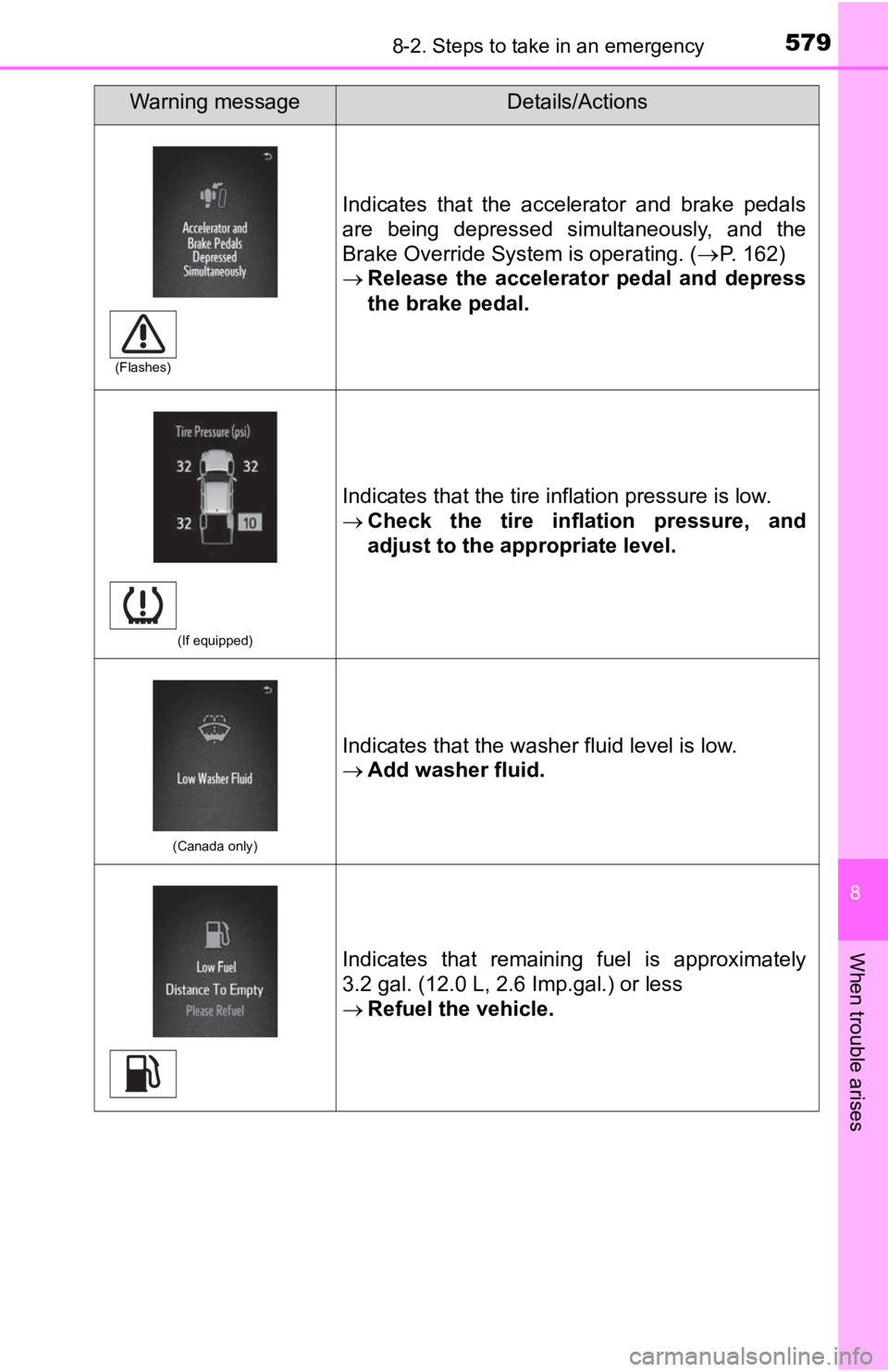
5798-2. Steps to take in an emergency
8
When trouble arises
Indicates that the accelerator and brake pedals
are being depressed simultaneously, and the
Brake Override System is operating. (
P. 162)
Release the accelerator pedal and depress
the brake pedal.
(If equipped)
Indicates that the tire inflation pressure is low.
Check the tire inflation pressure, and
adjust to the appropriate level.
(Canada only)
Indicates that the washer fluid level is low.
Add washer fluid.
Indicates that remaining fuel is approximately
3.2 gal. (12.0 L, 2.6 Imp.gal.) or less
Refuel the vehicle.
Warning messageDetails/Actions
(Flashes)
Page 612 of 700
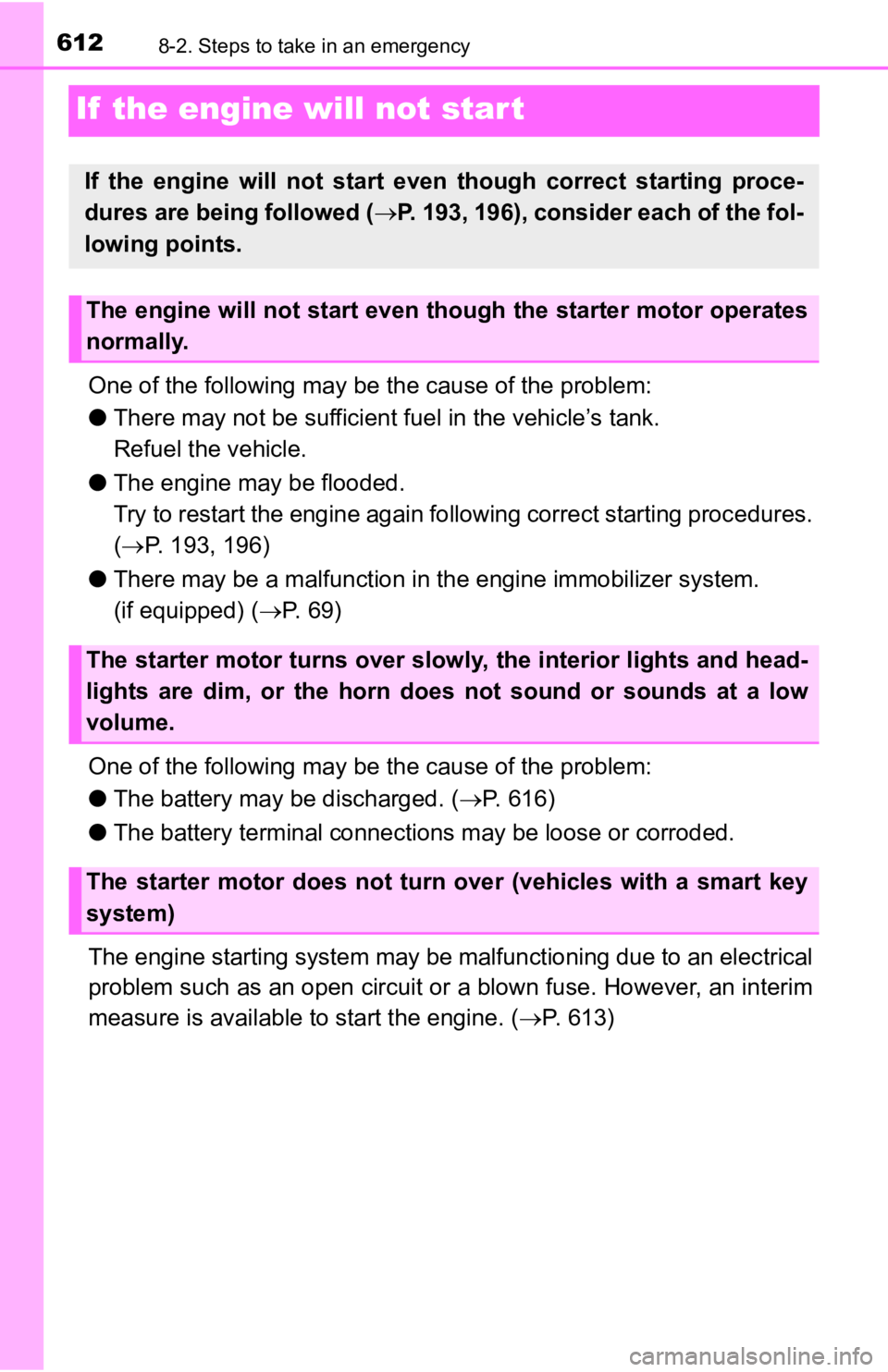
6128-2. Steps to take in an emergency
If the engine will not star t
One of the following may be the cause of the problem:
● There may not be sufficient f uel in the vehicle’s tank.
Refuel the vehicle.
● The engine may be flooded.
Try to restart the engine again following correct starting proc edures.
( P. 193, 196)
● There may be a malf unction in the engine immobilizer system.
(if equipped) ( P. 69)
One of the following may be the cause of the problem:
● The battery may be discharged. ( P. 616)
● The battery terminal connecti ons may be loose or corroded.
The engine starting system may be malfunctioning due to an elec trical
problem such as an open circuit or a blown fuse. However, an in terim
measure is available to start the engine. ( P. 613)
If the engine will not start eve n though correct starting proce -
dures are being followed ( P. 193, 196), consider each of the fol-
lowing points.
The engine will not start even t hough the starter motor operates
normally.
The starter motor turns over slowly, the interior lights and he ad-
lights are dim, or the horn does not sound or sounds at a low
volume.
The starter motor does not turn over (vehicles with a smart key
system)
Page 625 of 700

625
9Vehicle specifications
9-1. SpecificationsMaintenance data (fuel, oil level, etc.) .......... 626
Fuel information ................ 640
Tire information ................. 643
9-2. Customization Customizable features ...... 654
9-3. Items to initialize Items to initialize ............... 662